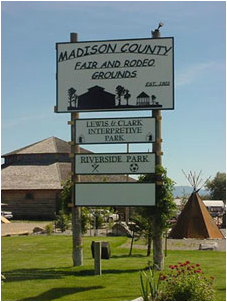|
Where the rivers meet...Twin Bridges’ unique geological conjunction of the rivers of the Beaverhead, Big Hole, Ruby and Jefferson affords people of all times a home and enterprise.
Twin Bridges serves as the primary community and service center for the immediate area. It has full services and still maintains the character of a small town. The nearest medical services such as hospital, medical clinic, ambulance and QRU are available at Sheridan (9 miles south on Highway 287) and Dillon (about 25 miles southwest on Highway 41). |
|

The community is becoming more fractured as new residents move in and larger parcels of land are taken out of agricultural production. The area is taking on more of the attributes of its nearby sister cities, Virginia City and Ennis, in that tourism is becoming an ever increasing part of the area economy. No large scale planned rural development is apparent in the area, however, sporadic residential development is well evidenced, mostly on rural acreage tracts of 5 to 20 acres.
Cattle and agriculture are predominate in the area. The East Bench Irrigation Project prospers with the production of alfalfa, grains and potatoes.
Surrounded by the beauty of the Tobacco Root, Highland, McCartney and Ruby mountains, abundant wildlife, rivers, streams and lakes, Twin Bridges boats an excellent school system, airport and business community to meet your needs. R.L. Winston Rod Company is headquartered at Twin Bridges, Montana, and many outstanding fly fishing guides and shops are located throughout the area.
Location: Twin Bridges, Montana is located in southwestern Montana and Madison County, 26.5 miles southwest of Virginia City, the county seat of Madison County, via State Highway #287, 27 miles east of Dillon, 78 miles southwest of Bozeman and 55 miles southeast of Butte. Dillon, Butte and Bozeman are the major trade centers for the area.
Population: 400 according to the 2000 US Census with the local zip code serving 915.
Schools: Both grade and high school for the area are located in Twin Bridges, with school bus service available at the county road.
Cattle and agriculture are predominate in the area. The East Bench Irrigation Project prospers with the production of alfalfa, grains and potatoes.
Surrounded by the beauty of the Tobacco Root, Highland, McCartney and Ruby mountains, abundant wildlife, rivers, streams and lakes, Twin Bridges boats an excellent school system, airport and business community to meet your needs. R.L. Winston Rod Company is headquartered at Twin Bridges, Montana, and many outstanding fly fishing guides and shops are located throughout the area.
Location: Twin Bridges, Montana is located in southwestern Montana and Madison County, 26.5 miles southwest of Virginia City, the county seat of Madison County, via State Highway #287, 27 miles east of Dillon, 78 miles southwest of Bozeman and 55 miles southeast of Butte. Dillon, Butte and Bozeman are the major trade centers for the area.
Population: 400 according to the 2000 US Census with the local zip code serving 915.
Schools: Both grade and high school for the area are located in Twin Bridges, with school bus service available at the county road.

History: Four Indian trails converge at a natural ford in the bend of the Beaverhead near today’s Twin Bridges school. Since Indian trails were direct, they were used by early settlers and freighters helping to center community life. In 1805 Lewis and Clark’s main expedition camped on the Beaverhead south of Twin Bridges.
Brothers, M.H. and John T. Lott are credited with establishing the town in 1864 and after 130 years, their descendants still reside here along with the friendly community of ranchers, retirees, businessmen and women, artists, recreationists and pioneers. In 1865 the Lott Brothers built bridges across the Beaverhead and Big Hole Rivers. Feeling this would be the hub of the valley, they began constructing and improving roads. For several years lots were given by the Lott brothers to all who would build on them. Land was also donated for public buildings. As the town prospered new businesses sprang up. It became evident a bank should be located here as a convenience to merchants, residents, miners and farmers of the area. The Bank of Twin Bridges was organized in 1898 and by the turn of the century there were three hotels and dining rooms, grain elevator, two garages, creamery, theater building, two blacksmith shops, two churches, new schools, saloons, Chinese laundry and restaurant, and other enterprises. The telephone system was established in 1900, the electricity in 1911, and the water system in 1914. The town was incorporated in 1902 with M.H. Lott as mayor.
Brothers, M.H. and John T. Lott are credited with establishing the town in 1864 and after 130 years, their descendants still reside here along with the friendly community of ranchers, retirees, businessmen and women, artists, recreationists and pioneers. In 1865 the Lott Brothers built bridges across the Beaverhead and Big Hole Rivers. Feeling this would be the hub of the valley, they began constructing and improving roads. For several years lots were given by the Lott brothers to all who would build on them. Land was also donated for public buildings. As the town prospered new businesses sprang up. It became evident a bank should be located here as a convenience to merchants, residents, miners and farmers of the area. The Bank of Twin Bridges was organized in 1898 and by the turn of the century there were three hotels and dining rooms, grain elevator, two garages, creamery, theater building, two blacksmith shops, two churches, new schools, saloons, Chinese laundry and restaurant, and other enterprises. The telephone system was established in 1900, the electricity in 1911, and the water system in 1914. The town was incorporated in 1902 with M.H. Lott as mayor.
Older than Montana, but younger than ever, Twin Bridges welcomes you to visit!

